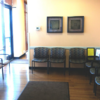
17 Best Natural Medicines to Stop Allergies
If you suffer from allergies, you may be considering natural medicines to help alleviate your symptoms. Natural...
Read moreHelp patients book appointments with you on Solv. It's free!
1 instant-book location




Help patients book appointments with you on Solv. It's free!
Compared to other states, Wyoming has an encouraging healthcare environment that meets the needs of most people. There are some concerns, especially regarding indigenous populations living on reservations, but the state has plans to improve access for these groups.
With plenty of walk-in clinics and urgent care centers, people living in Wyoming have options that can help them avoid high-priced emergency rooms.
The United States has an average of 87.4 people living on each square mile of land. In Wyoming, only 5.8 people occupy a square mile. Considering that Laramie, the state's largest city, has 2,844 people per square mile, many people living outside of the city have to travel long distances to find any healthcare services.
People in Wyoming should look for the closest urgent care centers to decide whether there are nearby options. Urgent care centers can provide non-emergency, preventative, and general wellness care. Instead of spending a lot of money at an emergency room (not to mention filling it up, making access harder for people who truly need emergency care), you can choose an urgent care center that meets your healthcare needs.
Wyoming has several healthcare networks that give patients access to urgent care centers. Some options include College Drive Urgent Care and Express Urgent Care in Cheyenne; Urgent Care of Casper in Casper; and the Family Health and Urgent Care Center at St. John's Medical Center in Jackson.
Several Indian reservations also have urgent care centers that can meet the needs of the native people.
The price charged at an urgent care, whether in Wyoming or elsewhere, will be based on the location, and there are no actual standard costs between the clinics. Assuming you are paying with cash, you might come across an urgent clinic that charges you $50 while another situated some mile away charges you $100 for the same services. The standard cost in urgent care where insurance cover is not involved ranges from $100 to $125. This price is generally the standard price of a visit before extra services. There are a couple of additional care services that could make your appointment to an urgent care costly including x-rays and lab tests, medications and injections (such as immunization), casting broken bones, as well as stitches and splints. If you have a viable insurance plan in place, the standard pay will be between $20 – 50 depending on your insurance coverage and whether you are in contact with the provider.
Most primary care doctor offices are open during routine work hours, Monday thru Friday, 9:00 am to 5:00 pm. Conversely, most of the urgent care centers in Wyoming are available after hours, on weekends, and many holidays. Typical urgent care hours are 8:00 am to 8:00 pm daily, although location-specific hours may vary.
Historically, urgent care centers were strictly an on-demand, walk-in healthcare service mode. More recently, as consumer behaviors and expectations have evolved, many urgent care clinics have begun offering book ahead visits, allowing consumers to select a same-day or next-day time that works best for their schedule. Use Solv to find a Wyoming urgent care center that offers advanced bookings (or appointments) and book online.
Solv allows Wyoming residents and visitors to book urgent care visits online with just a few taps. Same-day and next-day visit times are generally available, and you can search for real-time availability clinics.
Solv allows you to find any of the urgent care and walk-in clinics in Wyoming, many of which accept most major commercial insurances. Just browse the clinics page to see if your carrier and plan is listed. If you are still unsure, it is best to contact the urgent care center directly for clarification.
Many urgent care centers, including those in Wyoming, now offer virtual visits or telemedicine for residents and visitors throughout the state. Virtual urgent care visits are generally booked online whether in advance or on-demand. Clinics that do offer virtual care have a video icon on their profiles.
While it would be easy to provide a list of urgent care centers in and around Wyoming, 'best' is a challenging term to qualify. For some consumers, that could mean the closest location whereas other people may prioritize patient reviews, service costs, availability, or whether or not the provider accepts their insurance. With the list of locations above, use the filters provided to narrow the results to find the best urgent care for your needs.
Urgent care is available to assist patients that are looking for immediate, convenient medical care. In that manner, they are similar to an emergency room. The difference, however, is that ERs are meant to treat major, life-threatening injuries and illnesses while urgent care centers manage life’s minor bruises and bumps. In simple terms, an urgent care is seen as a walk-in health center that focuses in offering non-emergent health care conditions, including the treatment of the typical illnesses and injuries such as fractures and sprains, cuts and burns, scrapes, stings and bites, flu and cold symptoms, nausea and vomiting, abdominal pain, and much more. Most urgent care facilities offer both diagnostic and preventive care such as well visits, immunizations, STD testing and annual physicals. For regular visits and check-ups on these clinics, you should expect to pay between $20 and $100. The good thing is that most urgent care clinics will accept major PPOs and insurance cover, Medicare, as well as self-pay in the form of credit cards or cash. Urgent care clinics are located in most parts of the country in various regions to offset emergency room visits and provide a gap in healthcare services. They take patients during all hours of operations, which offer a significant convenience to most people who have and continue to undergo the need for sudden and immediate medical attention.
Chickenpox Vaccine in Wyoming
DOT Exam in Wyoming
Ear Wax Removal in Wyoming
Flu Shot in Wyoming
Hepatitis Vaccine in Wyoming
Measles Vaccine (MMR) in Wyoming
Physical Exam in Wyoming
Shingles Vaccine in Wyoming
Sports Physicals in Wyoming
Tetanus Shot in Wyoming
Typhoid Vaccine in Wyoming
Yellow Fever Vaccine in Wyoming
A1C Test in Wyoming
Allergy Testing in Wyoming
Blood Test in Wyoming
CMP Test in Wyoming
COVID-19 Antibody Test in Wyoming
Chlamydia Test in Wyoming
Cholesterol Test in Wyoming
Food Allergy Testing in Wyoming
Glucose Test in Wyoming
Hepatitis test in Wyoming
Mono Test in Wyoming
RSV Test in Wyoming
STD Testing in Wyoming
Strep Test in Wyoming
TB Test in Wyoming
Trichomonas Test in Wyoming
Urinalysis in Wyoming
Vitamin D Test in Wyoming
Tips, advice, news—your resource to stay healthy and safe while improving your experience with healthcare providers when you need them.